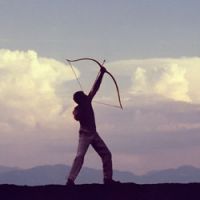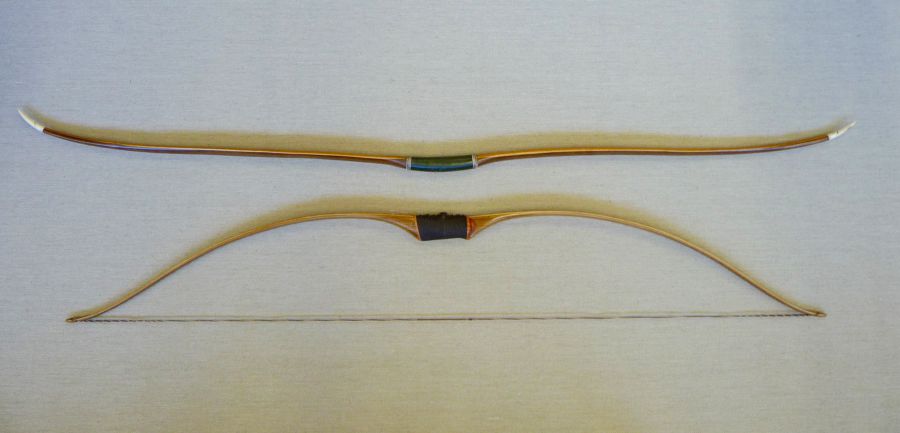
 |
Conservation and study of bows : Antiquity and the Middle Ages
|
| |
With all his research he has conducted in relation to various museums around the world, Blaise Fontannaz observed after prehistory, the sharp increase in manufacturing techniques and performance of solid wood and composite bows.
Major developments have taken place since the late Neolithic and early Bronze Age. The two main types of bow that are so common in Europe, are the straight bow and bow reflex double curvature.
Used for hunting and war, the bow straight Yew was the most common because the most efficient, particularly in Europe.
Indeed, by its almost unique feature, yew wood has a flexible sapwood, filling the role of natural extension, undissociated his heartwood (hard and nervous), filling the role of natural compression.
When the branches tree or whole trees are felled at the right time of year (winter dark moon), wood sap off is more dense and strong.
In addition, selected with a form of "reflex" (naturally curved in the opposite direction to the string ), the bow will be all the more nervous and shape resiliency find a best original position.
The simplest form of this straight bow, drawing “half-moon”, will remain the most prevalent until today and around the world, as easy to manufacture, it is enough to hunt and defend the clans.
Morgex Bow ( collection Prestige )

Morgex Bow draw( collection Prestige)
The second type and form bow recognized from the Bronze Age, is the form "dual reflex". Probably evolved for increased performance that gives a bow, but especially wood other than that yew and are more likely to lose their shape resilience (important "follow rope/string").
With a smart but simple assembly to the riser to force the limb slightly reflex and the ends of the additional limbs bent reflexes by natural selection or manual process (hot steam or oil ), this bow dual reflex will, for a time, the competitor bow straight yew, in Europe.(Mediterranean / Egyptian Laburnum, hackberry, carob, tamarisk, etc.)
In the Mediterranean region, the Middle East, Asia, conquering civilizations embrace this powerful model to improve the horn and strengthening the sinew. (Egyptian / Hyksos, Sumerians, Assyrians, Scythians, Persians, etc.).
From the simple bow hunting, then this composite bow could break new fortified armor warriors and will be further improved by grafting (wood reported) and a marked propulsive curvature on both ends.
It will be the birth of the arc to "triple curvature" (East Asia) which ravage more tribes that all modern wars of the 19 and 20 centuries combined.
 Bow dual reflex
Bow dual reflex
Model up: "Bourgogne-Bourgeois" (17th) in laburnum with ivory dolls.
Model down: reconstruction(pageant) laburnum 4 laminating , string rope not touching the drawing bow.
In late few centuries of close and Eastern civilizations, our Mediterranean Europe, has largely simple bow yew know the dual reflex bows by the partial interim of Celtic civilization, original "East Indian".
The laburnum is the witness Mediterranean, from Egypt to the Alps, through the Greek Isle of Kytisos or by Morocco, this bow Cretan or Moorish, also permeate the European archery.
The laburnum bow type "Bourguignon" by designation, will be the worthy heir, through the laburnum endemic settlements created by humans in the Alps and into northern Sweden / Norway.
He will become the competitor of the English longbow in the 15th, and the first competition of the 19th and 20th between the Anglo-Saxon (UK and US), equipped with their longbows to become if legendary meet European equipped with some Bourguignon type bow in yew or laburnum.
During these confrontations, the Anglo-Saxons named this type of elegant bow “double-curves” whose string rope does not touch the bow, but forgotten by most of them, the "Continental Longbow."
(To see in the history of humanking in the first part of the treated bowmaker).
Arrowheads reconstitution hardened forged steel, from the early to the late Middle Ages
Longbow /Warbow “1415” Azincourt , Taxus Baccata, 81 inch /120# pounds
Arrows Azincourt ,cypress, natural feathers, horn nock, forged heads..
|